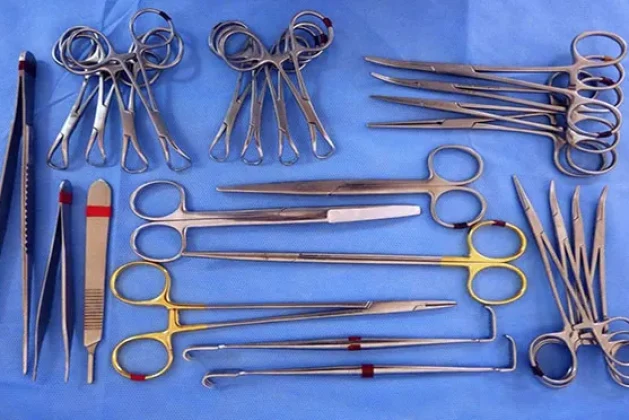Introduction
Precision and attention to detail are essential in the intricate world of rhinoplasty. Surgeons rely on an array of specialized rhinoplasty instruments to achieve the desired results, with the nasal rasp standing out as a fundamental tool. This article delves into the nasal rasp’s significance, its role in nasal surgery, and how it complements other instruments like nasal scissors in shaping and sculpting.
Whether refining a nasal hump or smoothing the contours, the nasal rasp ensures meticulous outcomes that align with patient expectations. Understanding this tool and its applications provides insights into the art and science of nasal surgery.
What Is a Nasal Rasp?
A nasal rasp is a specialized surgical instrument designed to shape and refine the bone and cartilage of the nose during rhinoplasty. It features a handle and a working end with a rough surface, often resembling a file, used to sculpt the nasal framework with precision.
These instruments come in various sizes and shapes, tailored to specific surgical needs. The nasal rasp’s ability to smooth irregularities or reduce prominent nasal structures makes it indispensable in modern nasal surgery.
The Role of Nasal Rasp in Rhinoplasty
Rhinoplasty, often called a “nose job,” involves altering the nose’s structure to improve function or aesthetics. The nasal rasp plays a pivotal role in achieving these goals by:
Smoothing Bone and Cartilage: After significant reshaping, rough edges may remain. A nasal rasp helps create a smoother, natural contour.
Precision Shaping: Surgeons use the nasal rasp to finely adjust the nasal dorsum (bridge) for symmetry and balance.
Minimizing Trauma: Its design ensures minimal disruption to surrounding tissues, reducing recovery time.
Customizing Results: The nasal rasp allows surgeons to tailor the nasal shape to the patient’s unique facial anatomy.
How Nasal Rasp Works with Other Rhinoplasty Instruments
While the nasal rasp is critical, it doesn’t work in isolation. Rhinoplasty requires a set of nasal surgery instruments, each serving a specific purpose. Here’s how it complements other tools:
Nasal Scissors: These are used to cut and trim tissues with precision. Once excess tissue is removed, the nasal rasp smooths the underlying structure for an even finish.
Osteotomes and Chisels: These tools break or reshape nasal bones. Afterward, the nasal rasp refines the work by addressing any remaining irregularities.
Speculums and Retractors: These instruments provide visibility and access, ensuring the nasal rasp can be used effectively without obstruction.
Forceps and Elevators: These facilitate the delicate handling of tissues, allowing the surgeon to position the nasal rasp accurately.
Benefits of Using Nasal Rasp in Surgery
The nasal rasp offers several advantages that make it an essential tool for surgeons performing rhinoplasty:
High Precision: Its textured surface enables controlled shaping of bone and cartilage.
Versatility: Available in various sizes and configurations, it suits various nasal structures and patient needs.
Durability: Made from high-quality surgical-grade materials, nasal rasps are built to withstand multiple procedures.
Improved Patient Outcomes: The nasal rasp contributes to a more refined and natural appearance by enabling precise adjustments.
Types of Nasal Rasp
Nasal rasps come in various designs, catering to specific surgical techniques. Some common types include:
Straight Rasps: Ideal for general shaping tasks.
Curved Rasps: Used for working on curved or hard-to-reach areas of the nasal framework.
Single-Cut Rasps: Designed for precise removal with minimal effort.
Double-Cut Rasps: Allow for faster shaping by cutting in both directions.
Each type is chosen based on the surgeon’s preference and the complexity of the procedure.
explore more latest details about the Hand Surgery Instruments Set
Maintaining Rhinoplasty Instruments for Optimal Performance
Proper maintenance of nasal surgery instruments, including the nasal rasp, is crucial for longevity and effectiveness. Here are some essential tips:
Cleaning: Instruments should be thoroughly cleaned immediately after use to remove biological debris.
Sterilization: Autoclaving ensures all rhinoplasty instruments are sterilized, preventing infections.
Inspection: Regular checks for wear or damage ensure the nasal rasp and other tools remain functional.
Proper Storage: Storing instruments in dedicated cases protects them from damage and contamination.
Surgeons can deliver consistent results and enhance patient safety by maintaining these tools.
Innovations in Nasal Surgery Instruments
Advancements in medical technology have led to improved designs for nasal rasps and other rhinoplasty instruments. Today’s tools are more ergonomic, precise, and durable, enabling surgeons to confidently perform complex procedures.
For example, modern nasal rasps may feature diamond coatings for smoother operation and enhanced durability. Similarly, innovations in nasal scissors ensure cleaner cuts with minimal tissue trauma.
Choosing the Right Rhinoplasty Instruments
Selecting the appropriate instruments is key to a successful rhinoplasty. Surgeons consider factors such as the patient’s anatomy, the complexity of the procedure, and the desired outcome. High-quality nasal surgery instruments, including a well-crafted nasal rasp, are non-negotiable for achieving optimal results.
Factors like material quality, ease of use, and manufacturer reputation play vital roles when investing in rhinoplasty tools. Many surgeons also prefer instruments that balance traditional craftsmanship and modern innovation.
Patient Perspective: Why Precision Matters in Rhinoplasty
From a patient’s viewpoint, the precision offered by tools like the nasal rasp translates to better outcomes and satisfaction. Some of the visible benefits are a smoother nasal bridge, symmetrical contours, and minimized irregularities.
Moreover, using advanced nasal surgery instruments reduces the risk of complications, shortens recovery time, and enhances the overall experience for patients undergoing rhinoplasty.
Conclusion
The nasal rasp is an indispensable instrument in the field of rhinoplasty, offering surgeons the precision and control needed to sculpt the nose with accuracy. When combined with other rhinoplasty instruments like nasal scissors, speculums, and forceps, it helps create balanced and aesthetically pleasing results.
For patients and surgeons alike, understanding the tools behind the artistry of nasal surgery highlights the importance of quality and innovation in achieving successful outcomes. As technology advances, instruments like the nasal rasp will continue to evolve, ensuring the future of rhinoplasty remains bright and promising.




Leave a comment